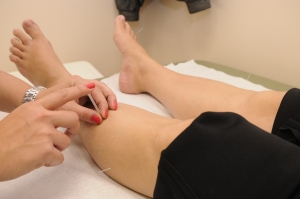Top 10 IntegrativePractitioner.com news and commentary of 2016
December 27, 2016
 From homeopathy to Ayurveda, we brought readers around the world of integrative medicine with the issues and trends relevant to you, your patients, and your practice. Integrative healthcare saw a lot of changes and challenges this year and we’ve rounded some of our most popular news and commentary to help you reflect and prepare for the year ahead. Click through to find out which articles were the most popular among readers in 2016. Editor’s note: This is the first of a four-part series where IntegrativePractitioner.com will ring in the New Year by looking back at news, policies, trends, and other topics that resonated with our audience in 2016. Check back throughout the week for our latest round-up.
From homeopathy to Ayurveda, we brought readers around the world of integrative medicine with the issues and trends relevant to you, your patients, and your practice. Integrative healthcare saw a lot of changes and challenges this year and we’ve rounded some of our most popular news and commentary to help you reflect and prepare for the year ahead. Click through to find out which articles were the most popular among readers in 2016. Editor’s note: This is the first of a four-part series where IntegrativePractitioner.com will ring in the New Year by looking back at news, policies, trends, and other topics that resonated with our audience in 2016. Check back throughout the week for our latest round-up.  10. Colds & Flu—A homeopathic perspective A recent recall of over the counter cold and cough medicines has left parents scurrying to find a stop gap treatment measure for their children and themselves. Nancy Gahles, DC, CCH, RSHom(NA) discusses specific homeopathic remedies and their benefits and suggests that the recall of these cold medicines opened the door for other avenues of healing. Unequipped with information about alternative therapies that can be effective for common viral syndromes, some people are simply trying anything from the over the counter products that are available. Adverse side effects and no relief are driving people back to the doctor’s office with the hope of “something else”. Often, medical doctors are either not trained in any specific alternative modality themselves, not educated enough to recommend one or do not have a referral base of qualified practitioners to refer to. Too frequently, patients are told that they have a virus and there is nothing they can do for it. Read it again: https://www.integrativepractitioner.com/whats-new/news-and-commentary/colds-flu-a-homeopathic-perspective/
10. Colds & Flu—A homeopathic perspective A recent recall of over the counter cold and cough medicines has left parents scurrying to find a stop gap treatment measure for their children and themselves. Nancy Gahles, DC, CCH, RSHom(NA) discusses specific homeopathic remedies and their benefits and suggests that the recall of these cold medicines opened the door for other avenues of healing. Unequipped with information about alternative therapies that can be effective for common viral syndromes, some people are simply trying anything from the over the counter products that are available. Adverse side effects and no relief are driving people back to the doctor’s office with the hope of “something else”. Often, medical doctors are either not trained in any specific alternative modality themselves, not educated enough to recommend one or do not have a referral base of qualified practitioners to refer to. Too frequently, patients are told that they have a virus and there is nothing they can do for it. Read it again: https://www.integrativepractitioner.com/whats-new/news-and-commentary/colds-flu-a-homeopathic-perspective/  9. Case Study: Lyme disease treatment with western medicine and acupuncture Explore a case study involving a 78 year old patient who received Lyme Disease treatment to address the severe recurring pain episodes he had been experiencing over the course of 16 months as a result of the disease. The disease (first identified in Lyme, Connecticut) is caused by a bacterium that is transmitted from deer to humans via a tick bite. Typical symptoms include fever, headache, fatigue and a bullseye skin rash. In the early stages, Lyme can generally be successfully treated with antibiotics. However, if left untreated, or in some individuals where antibiotics do not seem to be effective, the infection can spread to the joints, the heart, and the nervous system. Once this happens, chronic and debilitating symptoms can set in. Lyme Disease has become a scourge of the mid-Atlantic, Northeast and North-central United States. According to the Centers for Disease Control and Prevention, 64, 382 cases of Lyme disease were reported during the 2003-2005. In the worst hit states, rates of infection increased in each of these years, from 29.2 cases per 100,000 of population in 2003, to 31.6 cases per 100,000 in 2005. There are now 20,000 new cases reported each year. Read it again: https://www.integrativepractitioner.com/topics/environmental-health/case-studylyme-disease-western-medicine-and-acupuncture/
9. Case Study: Lyme disease treatment with western medicine and acupuncture Explore a case study involving a 78 year old patient who received Lyme Disease treatment to address the severe recurring pain episodes he had been experiencing over the course of 16 months as a result of the disease. The disease (first identified in Lyme, Connecticut) is caused by a bacterium that is transmitted from deer to humans via a tick bite. Typical symptoms include fever, headache, fatigue and a bullseye skin rash. In the early stages, Lyme can generally be successfully treated with antibiotics. However, if left untreated, or in some individuals where antibiotics do not seem to be effective, the infection can spread to the joints, the heart, and the nervous system. Once this happens, chronic and debilitating symptoms can set in. Lyme Disease has become a scourge of the mid-Atlantic, Northeast and North-central United States. According to the Centers for Disease Control and Prevention, 64, 382 cases of Lyme disease were reported during the 2003-2005. In the worst hit states, rates of infection increased in each of these years, from 29.2 cases per 100,000 of population in 2003, to 31.6 cases per 100,000 in 2005. There are now 20,000 new cases reported each year. Read it again: https://www.integrativepractitioner.com/topics/environmental-health/case-studylyme-disease-western-medicine-and-acupuncture/  8. Fibromyalgia misdiagnosis--what else could it be? It is important to know that only a small number of patients diagnosed with fibromyalgia actually suffer from this classic variety of the syndrome. As many as to 2/3 of people who are told they have fibromyalgia have actually received a fibromyalgia misdiagnosis and are really suffering from another problem. Fibromyalgia is the correct diagnosis only when all other medical and functional conditions have been ruled out. Doctors often use the single word fibromyalgia to diagnose a complex of symptoms that can have multiple causes. Worse yet, doctors often prescribe the same treatment package to all the patients they label with the term fibromyalgia. It is like using the term back pain and prescribing muscle relaxers to all patients with back pain. Sometimes the one-size-fits-all prescription may help patients get better, but not usually. Read it again: https://www.integrativepractitioner.com/whats-new/news-and-commentary/fibromyalgia-misdiagnosis-what-else-could-it-be/
8. Fibromyalgia misdiagnosis--what else could it be? It is important to know that only a small number of patients diagnosed with fibromyalgia actually suffer from this classic variety of the syndrome. As many as to 2/3 of people who are told they have fibromyalgia have actually received a fibromyalgia misdiagnosis and are really suffering from another problem. Fibromyalgia is the correct diagnosis only when all other medical and functional conditions have been ruled out. Doctors often use the single word fibromyalgia to diagnose a complex of symptoms that can have multiple causes. Worse yet, doctors often prescribe the same treatment package to all the patients they label with the term fibromyalgia. It is like using the term back pain and prescribing muscle relaxers to all patients with back pain. Sometimes the one-size-fits-all prescription may help patients get better, but not usually. Read it again: https://www.integrativepractitioner.com/whats-new/news-and-commentary/fibromyalgia-misdiagnosis-what-else-could-it-be/  7. Licensed acupuncturists achieve key recognition with U.S. government The value of the designation to licensed acupuncture and Oriental medicine practitioners reverberates in many directions. The release from NCCAOM—which has driven the campaign—states that the action will mean greater access to programming and recognition across all federal agencies. NCCAOM’s CEO Kory Ward-Cook, PhD, CAE expands, stating, “Earning a distinct Standard Occupational Code for Acupuncturists is a milestone moment for the acupuncture and Oriental medicine profession. This event positions acupuncturists for a number of new opportunities.” The independent Standard Occupational Code (SOC) code from the U.S. Bureau of Labor Statistics (BLS) will be “Acupuncturists – SOC – 29-1291.” While the recognition has been decided now, the new code will finally make it into the next edition of the BLS Occupational Handbook, which will be published in 2018. The campaign for designation following a startling awakening at a 2006 meeting of leaders of the acupuncture and Oriental medicine field when they learned that acupuncture had no independent status. In fact, it “was included as a modality under chiropractors and nurses, in the BLS Occupational Handbook.” Multiple acupuncture organizations participated in the effort to gain recognition with NCCAOM “spearheading” the effort. Read it again: https://www.integrativepractitioner.com/whats-new/news-and-commentary/licensed-acupuncturists-achieve-key-recognition-with-us-government/
7. Licensed acupuncturists achieve key recognition with U.S. government The value of the designation to licensed acupuncture and Oriental medicine practitioners reverberates in many directions. The release from NCCAOM—which has driven the campaign—states that the action will mean greater access to programming and recognition across all federal agencies. NCCAOM’s CEO Kory Ward-Cook, PhD, CAE expands, stating, “Earning a distinct Standard Occupational Code for Acupuncturists is a milestone moment for the acupuncture and Oriental medicine profession. This event positions acupuncturists for a number of new opportunities.” The independent Standard Occupational Code (SOC) code from the U.S. Bureau of Labor Statistics (BLS) will be “Acupuncturists – SOC – 29-1291.” While the recognition has been decided now, the new code will finally make it into the next edition of the BLS Occupational Handbook, which will be published in 2018. The campaign for designation following a startling awakening at a 2006 meeting of leaders of the acupuncture and Oriental medicine field when they learned that acupuncture had no independent status. In fact, it “was included as a modality under chiropractors and nurses, in the BLS Occupational Handbook.” Multiple acupuncture organizations participated in the effort to gain recognition with NCCAOM “spearheading” the effort. Read it again: https://www.integrativepractitioner.com/whats-new/news-and-commentary/licensed-acupuncturists-achieve-key-recognition-with-us-government/  6. Acupuncture and Traditional Chinese Medicine for thyroid health Biomedical disorders of the thyroid range from disruptions in its hypothalamic-pituitary-organ axis (e.g.: hypothyroidism, thyrotoxicosis (e.g.: hormone excess most frequently caused by Graves’ disease, hyperthyroidism and adenomas), morphologic dysfunction of the thyroid (e.g: benign disease, thyroid cancer, goiter, nodular dysfunction), and sick euthyroid syndrome (caused by almost any type of acute severe illness in the absence of underlying thyroid disease). The thyroid’s fitting name comes from the Greek thyreos and eidos (shield and form respectively). The thyroid is a highly vascular organ that coordinates the metabolism of almost all cells in the body based on the uptake of iodine, combination with tyrosine, and subsequent conversion to T3 and T4 hormones. The role of T3 and T4 are then control many metabolic reactions. Moreover, the thyroid axis is a wonderful example of a classic endocrine system feedback loop. In short, its hypothalamic-pituitary-organ signaling occurs due to cross-talk between the thyroid hormones T3 and T4, feedback of thyrotropin-releasing hormone (TRH), and pituitary production of thyroid-stimulating hormone (TSH). Read it again: https://www.integrativepractitioner.com/whats-new/news-and-commentary/acupuncture-and-traditional-chinese-medicine-for-thyroid-health/
6. Acupuncture and Traditional Chinese Medicine for thyroid health Biomedical disorders of the thyroid range from disruptions in its hypothalamic-pituitary-organ axis (e.g.: hypothyroidism, thyrotoxicosis (e.g.: hormone excess most frequently caused by Graves’ disease, hyperthyroidism and adenomas), morphologic dysfunction of the thyroid (e.g: benign disease, thyroid cancer, goiter, nodular dysfunction), and sick euthyroid syndrome (caused by almost any type of acute severe illness in the absence of underlying thyroid disease). The thyroid’s fitting name comes from the Greek thyreos and eidos (shield and form respectively). The thyroid is a highly vascular organ that coordinates the metabolism of almost all cells in the body based on the uptake of iodine, combination with tyrosine, and subsequent conversion to T3 and T4 hormones. The role of T3 and T4 are then control many metabolic reactions. Moreover, the thyroid axis is a wonderful example of a classic endocrine system feedback loop. In short, its hypothalamic-pituitary-organ signaling occurs due to cross-talk between the thyroid hormones T3 and T4, feedback of thyrotropin-releasing hormone (TRH), and pituitary production of thyroid-stimulating hormone (TSH). Read it again: https://www.integrativepractitioner.com/whats-new/news-and-commentary/acupuncture-and-traditional-chinese-medicine-for-thyroid-health/  5. MDs, DCs, NDs and LAcs: Who is a physician? A doctor level, non-MD academic friend from a conventional medical school who has expertise in complementary and alternative medicine inadvertently stepped into a militarized zone the other day. On a conference call with a multidisciplinary group of practitioners, he wished to make a distinction. He first offered a generalization about the roles of “chiropractors, naturopaths and acupuncturists.” Then he distinguished these from what he called “physicians.” But who is a physician? All of us knew that this studied academic was referring to licensed medical doctors, a.k.a. the kings (and queens) of the hill in U.S. medicine. At the same time, many of us were acutely aware by his comment that, while common and even professional usage of the term “physician” may connote MDs, legal realities are shifting. In fact, trends suggest that one endpoint of the movement toward integrative medicine is that “physician” will increasingly umbrella a rainbow of disciplines. Read it again: https://www.integrativepractitioner.com/whats-new/news-and-commentary/mds-dcs-nds-and-lacs-who-is-a-physician/
5. MDs, DCs, NDs and LAcs: Who is a physician? A doctor level, non-MD academic friend from a conventional medical school who has expertise in complementary and alternative medicine inadvertently stepped into a militarized zone the other day. On a conference call with a multidisciplinary group of practitioners, he wished to make a distinction. He first offered a generalization about the roles of “chiropractors, naturopaths and acupuncturists.” Then he distinguished these from what he called “physicians.” But who is a physician? All of us knew that this studied academic was referring to licensed medical doctors, a.k.a. the kings (and queens) of the hill in U.S. medicine. At the same time, many of us were acutely aware by his comment that, while common and even professional usage of the term “physician” may connote MDs, legal realities are shifting. In fact, trends suggest that one endpoint of the movement toward integrative medicine is that “physician” will increasingly umbrella a rainbow of disciplines. Read it again: https://www.integrativepractitioner.com/whats-new/news-and-commentary/mds-dcs-nds-and-lacs-who-is-a-physician/  4. Yoga alliance clarifies distinction from yoga therapy With an issued a statement last month, the Yoga Alliance sent a bombshell into the middle of the booming yoga field and drew a smart line distinguishing yoga teachers from the growing use of distinctions including “yoga therapy” and “yoga therapists.” The move came as a result of advocacy efforts targeted to reduce state regulation directed at yoga teacher training programs. The Yoga Alliance—registering yoga teachers and yoga teacher training programs – pulled the fuse. An apparent target, though not directly mentioned by the Yoga Alliance, was an entity that was a closely connected sister organization until 10 years ago, the International Association of Yoga Therapists (IAYT). The yoga industry worth was estimated to be $27-billion in 2013, with more than 36-million practitioners today. According to some estimates, the total number of those who teach yoga in the United States may be as many as a quarter of a million, of which more than 72,000 are registered with the Yoga Alliance. Read it again: https://www.integrativepractitioner.com/whats-new/news-and-commentary/yoga-alliance-clarifies-distinction-from-yoga-therapy/
4. Yoga alliance clarifies distinction from yoga therapy With an issued a statement last month, the Yoga Alliance sent a bombshell into the middle of the booming yoga field and drew a smart line distinguishing yoga teachers from the growing use of distinctions including “yoga therapy” and “yoga therapists.” The move came as a result of advocacy efforts targeted to reduce state regulation directed at yoga teacher training programs. The Yoga Alliance—registering yoga teachers and yoga teacher training programs – pulled the fuse. An apparent target, though not directly mentioned by the Yoga Alliance, was an entity that was a closely connected sister organization until 10 years ago, the International Association of Yoga Therapists (IAYT). The yoga industry worth was estimated to be $27-billion in 2013, with more than 36-million practitioners today. According to some estimates, the total number of those who teach yoga in the United States may be as many as a quarter of a million, of which more than 72,000 are registered with the Yoga Alliance. Read it again: https://www.integrativepractitioner.com/whats-new/news-and-commentary/yoga-alliance-clarifies-distinction-from-yoga-therapy/  3. An ayurvedic approach to osteoarthritis treatment Osteoarthritis (OA) is a chronic condition of the joints in which the cartilage cushioning the ends of the bones gradually loses its elasticity and wears away. Without the protective cartilage, the bones begin to rub against each other, causing stiffness, inflammation, and loss of movement. Osteoarthritis treatment therapies with current conventional medicine typically focuses on pain reduction and control of inflammation; however, these approaches have no effect on the natural course of the disease. The most common medications prescribed for osteoarthritis are, at best, moderately effective. In addition, side effects of these treatments can be quite significant, and at times life-threatening. Often times, the ultimate treatment for a disabling joint is joint replacement, with the inherent risks and cost that come with surgery. If current trends continue, it is estimated that 600,000 hip replacements and 1.4 million knee replacements will be carried out in the U.S. alone in 2015. Read it again: https://www.integrativepractitioner.com/whats-new/news-and-commentary/an-ayurvedic-approach-to-osteoarthritis/
3. An ayurvedic approach to osteoarthritis treatment Osteoarthritis (OA) is a chronic condition of the joints in which the cartilage cushioning the ends of the bones gradually loses its elasticity and wears away. Without the protective cartilage, the bones begin to rub against each other, causing stiffness, inflammation, and loss of movement. Osteoarthritis treatment therapies with current conventional medicine typically focuses on pain reduction and control of inflammation; however, these approaches have no effect on the natural course of the disease. The most common medications prescribed for osteoarthritis are, at best, moderately effective. In addition, side effects of these treatments can be quite significant, and at times life-threatening. Often times, the ultimate treatment for a disabling joint is joint replacement, with the inherent risks and cost that come with surgery. If current trends continue, it is estimated that 600,000 hip replacements and 1.4 million knee replacements will be carried out in the U.S. alone in 2015. Read it again: https://www.integrativepractitioner.com/whats-new/news-and-commentary/an-ayurvedic-approach-to-osteoarthritis/  2. Ginger and menstrual cramps Menstrual cramps are one of the most common problems that women face, affecting over 50 percent of menstruating women. Pain relief of primary dysmenorrhea, or painful menstrual cramps, is often well addressed with some simple botanical therapies. Ginger is one such plant, that offers practitioners a good option for their patients, and with not only a long history of traditional use, but some recent published research. A double-blind comparison trial was conducted in 150 reproductive aged college students 18 years and older, with primary dysmenorrheal. Women were divided into three groups. Group one received ginger (Zingiber officinale) rhizome powder capsules, 250 mg four times a day for three days starting day one of their menses. The second group received 250 mg mefenamic acid capsules, four times daily days one through three, and the third group took 400 mg ibuprofen capsules four times daily again, days one through three of the menses. Read it again: https://www.integrativepractitioner.com/topics/digestive-health/ginger-and-menstrual-cramps/
2. Ginger and menstrual cramps Menstrual cramps are one of the most common problems that women face, affecting over 50 percent of menstruating women. Pain relief of primary dysmenorrhea, or painful menstrual cramps, is often well addressed with some simple botanical therapies. Ginger is one such plant, that offers practitioners a good option for their patients, and with not only a long history of traditional use, but some recent published research. A double-blind comparison trial was conducted in 150 reproductive aged college students 18 years and older, with primary dysmenorrheal. Women were divided into three groups. Group one received ginger (Zingiber officinale) rhizome powder capsules, 250 mg four times a day for three days starting day one of their menses. The second group received 250 mg mefenamic acid capsules, four times daily days one through three, and the third group took 400 mg ibuprofen capsules four times daily again, days one through three of the menses. Read it again: https://www.integrativepractitioner.com/topics/digestive-health/ginger-and-menstrual-cramps/  1. Harvard study has good news for homeopathic medicine The American Journal of Public Health published a survey article out of Harvard that shows homeopathic medicine, while still only used by a small fraction of the U.S. population, jumped 15 percent in use. In addition, most users put homeopathy among the top 3 complementary and integrative strategies they use in their health care. The data was gleaned from the 2012 National Health Interview Survey. The researchers explored the prevalence and use patterns of homeopathic medicines among U.S. adults in relation to other complementary and integrative medicine (CIM) use. The survey found use of homeopathic medicines at 1.7 percent and 1.8 percent of the adult population, respectively. The 15 percent growth in the recent half-decade corresponds to an overall use rate of 2.1 percent in 2012. The most common conditions for which people sought homeopathic treatment were respiratory and ear-nose-and-throat complaints as well as musculoskeletal pain syndromes. Read it again: https://www.integrativepractitioner.com/whats-new/news-and-commentary/harvard-study-has-good-news-for-homeopathic-medicine/ Resolve to get involved with IntegrativePractitioner.com! We at IntegrativePractitioner.com aim to support the wide spectrum of integrative healthcare professionals in becoming more successful in their practices to effect positive improvements in the current standards of healthcare, policy, and to strengthen the common ground among all constituents. Our site is the destination for business networking relationships among companies and practitioners. Want to get more involved with our community in 2017? Here are a few ways you can make that resolution happen:
1. Harvard study has good news for homeopathic medicine The American Journal of Public Health published a survey article out of Harvard that shows homeopathic medicine, while still only used by a small fraction of the U.S. population, jumped 15 percent in use. In addition, most users put homeopathy among the top 3 complementary and integrative strategies they use in their health care. The data was gleaned from the 2012 National Health Interview Survey. The researchers explored the prevalence and use patterns of homeopathic medicines among U.S. adults in relation to other complementary and integrative medicine (CIM) use. The survey found use of homeopathic medicines at 1.7 percent and 1.8 percent of the adult population, respectively. The 15 percent growth in the recent half-decade corresponds to an overall use rate of 2.1 percent in 2012. The most common conditions for which people sought homeopathic treatment were respiratory and ear-nose-and-throat complaints as well as musculoskeletal pain syndromes. Read it again: https://www.integrativepractitioner.com/whats-new/news-and-commentary/harvard-study-has-good-news-for-homeopathic-medicine/ Resolve to get involved with IntegrativePractitioner.com! We at IntegrativePractitioner.com aim to support the wide spectrum of integrative healthcare professionals in becoming more successful in their practices to effect positive improvements in the current standards of healthcare, policy, and to strengthen the common ground among all constituents. Our site is the destination for business networking relationships among companies and practitioners. Want to get more involved with our community in 2017? Here are a few ways you can make that resolution happen: - Submit your content. IntegrativePractitioner.com is currently accepting content from those who are interested in distributing relevant published research or articles to our audience. E-mail [email protected] for more information.
- Join our social media. Engage with your peers in integrative medicine through our informal networking platform via LinkedIn. Click here to become a member. Check us out on Facebook and Twitter, too. We encourage you to ask questions and communicate with us through all of our social media channels.
- Sign up for our newsletter. Stay up to date with all news, commentary, and other tools we have to offer in this weekly e-mail. Click here to subscribe.




















SHARE